Calix continues to drive innovation and broadband service provider success by integrating Calix Support Cloud with more than 100 third-party residential gateways, opening the full range of award-winning support and testing services with no need for new or additional hardware
SAN JOSE, CA—April 21, 2022—Calix, Inc. (NYSE: CALX) announced today that it continues to deliver on its commitment to open industry standards for broadband service providers (BSPs). The award-winning Calix Support Cloud (Support Cloud)—which helps BSPs of any size reduce truck rolls by as much as 46 percent and increase first-call resolutions by as much as 74 percent—now fully integrates with more than 100 third-party gateways. A growing number of BSPs are leveraging Support Cloud to transform their call centers, because even those with legacy equipment in subscriber homes can enjoy the full benefits of the solution. Calix has long supported open industry standards that provide BSPs with the flexibility to innovate at their own pace. By combining the flexibility and speed of open source with the efficiencies of interoperability and open standards, Calix opens a world of opportunity for BSPs to simplify their operations, excite their subscribers, and grow their revenue.
Calix supports BSP business transformations by:
“We first became a Calix Support Cloud customer to help us perform critical FCC performance testing, but Support Cloud integration with our gateways has created tremendous value for us,” said Cody Mitchell, TAC Supervisor for Blackfoot Telephone Cooperative, serving western Montana and eastern Idaho. “We have seven different gateways that communicate at least some information to the Support Cloud. Calix gives us the flexibility to conduct performance testing no matter what device is on the customer’s premises.”
“We have leveraged Calix software platforms essentially from their beginning; influencing their development through early adopter programs,” said Jason Jenkins, Network Manager at Silver Star Communications, which also serves Wyoming and Idaho. “Calix software has allowed us to associate both Calix and alternate vendor CPE to provide a near-seamless experience for all service delivery methods. We have also leveraged Support Cloud NetOps to complete our ACAM II preliminary testing quickly, without the need to deploy additional hardware or software.”
“Calix is committed to serving our customers with open-source innovation that eliminates the need for closed, proprietary ecosystems,” said Matt Collins, executive vice president for commercial operations and chief marketing officer. “Each of our customers faces a unique set of challenges at both ends of the subscriber experience. Calix Cloud helps even the smallest BSP successfully address those challenges. Furthermore, our active support of open industry standards fosters development of new standards and encourages innovation so BSPs can transform their businesses, own their markets, and grow value for themselves and their communities.”
Discover why Calix believes open industry standards accelerate innovation for all.
About Calix
Calix, Inc. (NYSE: CALX) – Calix cloud and software platforms enable service providers of all types and sizes to innovate and transform. Our customers utilize the real-time data and insights from Calix platforms to simplify their businesses and deliver experiences that excite their subscribers. The resulting growth in subscriber acquisition, loyalty, and revenue creates more value for their businesses and communities. This is the Calix mission; to enable broadband service providers of all sizes to simplify, excite, and grow.
This press release contains forward-looking statements that are based upon management’s current expectations and are inherently uncertain. Forward-looking statements are based upon information available to us as of the date of this release, and we assume no obligation to revise or update any such forward-looking statement to reflect any event or circumstance after the date of this release, except as required by law. Actual results and the timing of events could differ materially from current expectations based on risks and uncertainties affecting Calix’s business. The reader is cautioned not to rely on the forward-looking statements contained in this press release. Additional information on potential factors that could affect Calix’s results and other risks and uncertainties are detailed in its quarterly reports on Form 10-Q and Annual Report on Form 10-K filed with the SEC and available at www.sec.gov.
Press Inquiries:
John Husson
410-979-1747
john.husson@calix.com
Investor Inquiries:
Investor Relations
investorrelations@calix.com

San Jose, Calif. – April 19, 2022 – NETGEAR®, Inc. (NASDAQ: NTGR), the leading provider of networking products that power businesses both large and small, today announced the latest addition to its managed wireless access point portfolio, the Insight Managed WiFi 6 AX3000 Dual-band Multi-Gig PoE Access Point (WAX615). Developed for small and medium businesses (SMBs), the WAX615 provides the fastest dual-band, WiFi 6, multi-gig performance and coverage with NETGEAR Insight remote cloud management and the NETGEAR unique Instant Mesh capability.
Broadband internet access for businesses has broken the Gigabit per second speed limit. End-point device WiFi speeds have increased as WiFi technology has evolved from one generation to the next. Businesses must upgrade their WiFi infrastructure to keep up with customer demand as well as data-driven business operations. The WAX615 provides SMBs and managed service providers with a powerful WiFi solution based on the latest WiFi 6 Release 2 technology, delivering twice the throughput compared to WiFi 6 Release 1, at a price comparable to its immediate predecessor. The WAX615 is backwards compatible with all NETGEAR Insight Managed WiFi 5 and WiFi 6 Access Points, making it an easy, drop-in upgrade to existing Insight networks.
With a top speed of 3Gbps, superior range and easy setup, the WAX615 access point delivers seamless roaming, load balancing and multi-user access for the best WiFi experience in high density environments. The device also includes one-year free Insight subscription for fully centralized, real-time setup, monitoring, and control with no need for extra management hardware. Furthermore, the WAX615 features one 2.5Gbps Power-over-Ethernet (PoE) Ethernet port for faster wired connectivity and easy installation. It’s ideally paired with NETGEAR GSM4210P, MS510TXPP, MS510TXUP and MS108EUP PoE switches.
“The WAX615 is yet another example of NETGEAR’s commitment to innovation and delivering superior WiFi solutions to customers,” said Douglas Cheung, director of product line management for NETGEAR Business Wireless. “The result of our innovation is the WAX615 that delivers higher data throughput, improved network efficiency, and a better user experience, all while maintaining management consistency across generations of products and at an attractive price point.”
Unprecedented Business Class WiFi 6 Security
Small and medium organizations can enjoy enterprise level security without expenditures typically associated with this class of product. NETGEAR Insight makes it simple to configure and maintain network security with features that include:
Insight Managed WiFi 6 AP Lineup
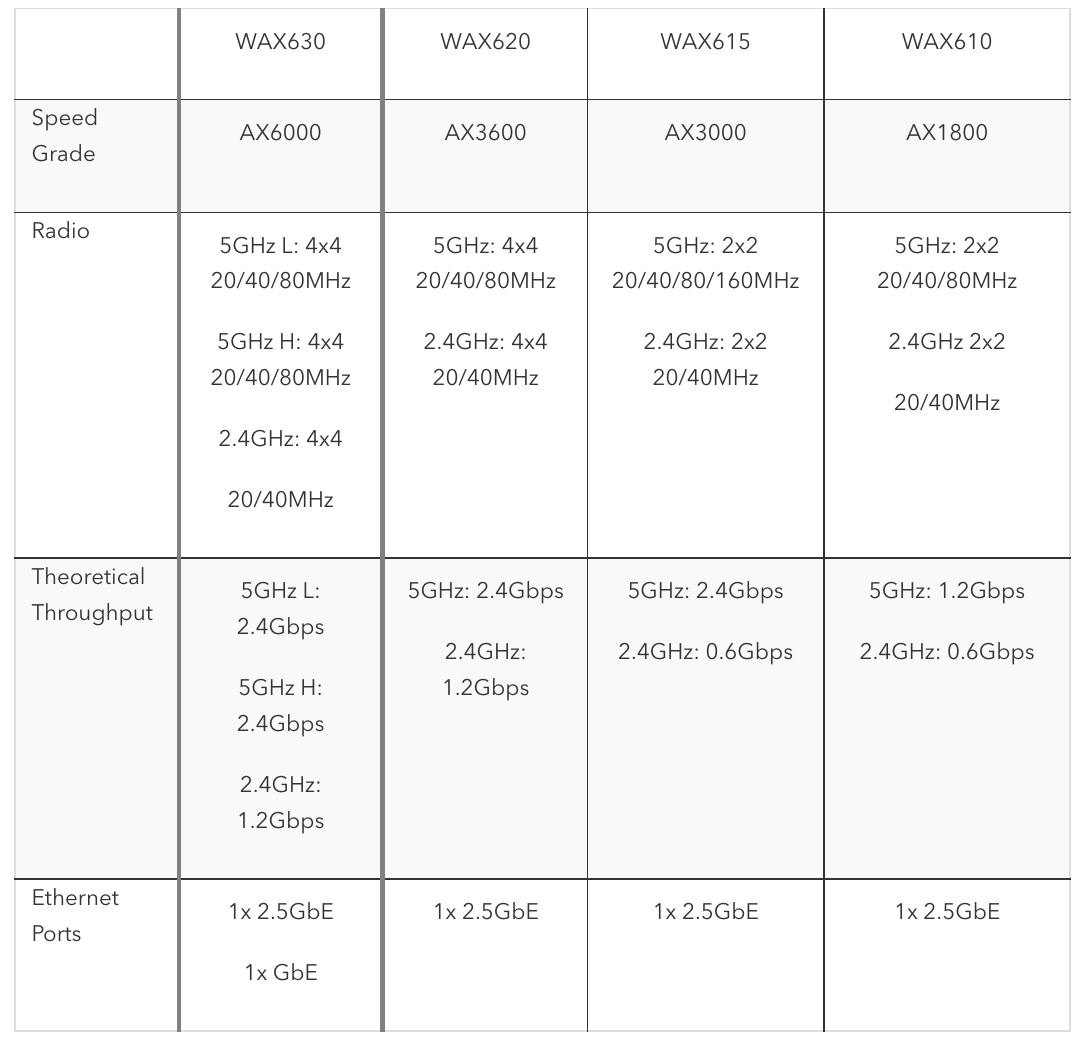
Additional Features:
Availability
NETGEAR® Insight Managed WiFi 6 AX3000 Dual-band Multi-Gig PoE Access Point (WAX615) is available this month on NETGEAR.com.
About NETGEAR, Inc.
NETGEAR® (NASDAQ: NTGR) has pioneered advanced networking technologies for homes, businesses, and service providers around the world since 1996 and leads the industry with a broad range of award-winning products designed to simplify and improve people’s lives. By enabling people to collaborate and connect to a world of information and entertainment, NETGEAR is dedicated to delivering innovative and advanced connected solutions ranging from mobile and cloud-based services for enhanced control and security, to smart networking products, video over Ethernet for Pro AV applications, easy-to-use WiFi solutions and performance gaming routers to enhance online game play. The company is headquartered out of San Jose, Calif. with offices located around the globe. More information is available from theNETGEAR Investor Pageor by calling (408) 907-8000. Connect with NETGEAR:Twitter,Facebook,Instagramand theNETGEAR blogatNETGEAR.com.
Source: NETGEAR-G
U.S. Media Contact:
U.S. Sales Inquiries:(408) 907-8000, sales@netgear.com
Overview
The digital economy has transmuted how businesses are structured, how firms interact, and how consumers obtain services and information.
An efficient digital-based economy requires the deployment of technology infrastructure that is ubiquitous, high-speed, secure, and flexible for developing a digital supply chain, which can be used by businesses to transform the way they operate.
The pandemic has forced the world to adapt and change. The emergence of a flexible hybrid model of connectivity, which is pandemic-induced, has necessitated enterprises to rethink their go-to-market strategies, workforce management practices, and digital business processes.
Hyper-converged wireless connectivity ties together businesses with technology to bring aggressive economics into play.
Challenges
A report by United Nations suggests that nearly 3 billion people – or 37% of the world’s population – have never used the Internet, despite the pandemic driving people online. The unconnected economy is a huge missed opportunity for enterprises to become future-proof by providing their consumers with access to the best products, services, and experiences. Telecom operators to blur this digital divide delve into new ways to manage costs and provide Internet for all, but the demand remains unfulfilled due to commercialization, competition, and license fee pressure.
Solution
TIP- building a roadmap for industry transformation. The disaggregated network is becoming a reality for enterprises, allowing them to build larger, more robust networks and offer innovative services to their customers. Telecom Infra Project (TIP) has established an Open Platform to build cost-efficient and flexible networks that can be tailored to specific business needs and preferences, intending to bring ubiquitous connectivity to all. TIP’s Open Platform brings telecom operators, system integrators, and other stakeholders together to build a flexible, high-speed, and lower-cost network that can connect all areas of a city or region.
OpenWiFi is an initiative designed to assemble a “fully disaggregated Wi-Fi system,” including a cloud controller SDK and Enterprise-grade Access Points, designed and validated to work seamlessly together. The validation and certification infrastructure ensures all components and Access Points are robust to interoperate seamlessly. Some of its salient features include community-driven development, interoperable multiple vendors, no vendor lock-in, and reduced TCO.
Its tech stack comprises advanced enterprise and Carrier-grade features, including open APIs, open-source core, choice of controllers, interoperable open interface, and choice of HW – multiple vendors / models, and standard air interface.
It enables connectivity providers, such as SPs, MSPs, MNOs, MSOs, businesses to connect with wireless Internet, hotspot, roaming/offload, etc. It is developed by the OEMs using the OpenWiFi stack to add value for WLANaaS, security, UX, etc.
The open-source community supports cloud-native controller software and manages & controls distributed Wi-Fi deployment. It has feature-rich integrated AP firmware, a production-ready image, and a single code base for all Whitebox platforms (Wi-Fi 5, 6 & 6E, indoor & outdoor)
IO by HFCL- building a holistic networking ecosystem with TIP
As one of the early adopters and partners of the TIP Open Wi-Fi ecosystem and tech stack, IO has brought a series of TIP-ready devices to achieve mass-market penetration of OpenWiFi to empower the connectivity ecosystem to grow and mature.
With extensive years of experience in designing and deploying access solutions worldwide, IO, in alliance with TIP, is actively deploying OpenWiFi based networks in Asia and Africa to
develop cost-effective open-source powered Access Points and wireless controllers.
“The vision of TIP OpenWIFi to connect everyone and everything and everywhere echoes through our goal to deliver high-quality connectivity over the length and breadth of the globe. We are confident that TIP and IO will continue to innovate and drive the next wave of innovation and will converge in the future. It is a platform where people and companies can build, share, and improve the ecosystem together.”
–Bhuvnesh Sachdeva, VP- IO product, HFCL Ltd.
Takeaway
OpenWiFi disaggregation unlocks untapped value for enterprises and service providers by enabling them to disaggregate their networks, reducing costs and improving operational efficiency. It also provides an opportunity for new players to enter the market and drive socio-economic development, by expanding the wireless footprint. The world is becoming increasingly connected and increasingly digital. IO’s mission is to improve lives by connecting people, information and things, and we do this through our innovative range of access solutions to enable people to interact, learn, work and engage, wherever and however they want, on any digital device. Our solutions are constantly evolving to meet the needs of our customers today and the challenges of the future. We are dedicated to delivering a better tomorrow by building a future-ready network connectivity ecosystem, with the most advanced technology.
Reach us to discover how we can empower your business with seamless connectivity.
Our Website: https://io.hfcl.com
This article is authored by Mr. Anuj Mago, Associate VP, HFCL Ltd
One of the first Wi-Fi 6E Operator boxes in the world, the new Livebox 6 is eco-responsible and offers the latest digital home services with the best Wi-Fi Experience possible
Paris, France – April 8th, 2022 – SoftAtHome, an independent software company for broadband, video, and analytics, is a central contributor to one of the world’s first Wi-Fi 6E operator box launches with Orange’s new Livebox 6.
One of the World’s First Wi-Fi 6E Operator Boxes
The new Livebox 6 allows Orange to provide the best Wi-Fi experience in terms of bandwidth and latency available today. The box brings Wi-Fi 6E, and its compatibility with the new Orange application “Orange et Moi” lets users manage the Livebox directly from their smartphone. SoftAtHome’s Wifi’ON Smart Wi-Fi product powers the Livebox 6. Subscribers will see improved in-home connectivity for a smoother Internet experience thanks to the next-gen Wi-Fi services that the 6E standard enable. Wi- Fi bandwidth can be rise to 2 Gbps. The added radio spectrum and automatic tri-band steering between 2.4 GHz, 5 GHz and 6 GHz bands drastically reduce network saturation to improve network experience while working from home or enjoying entertainment.
Ease of Use: Equipped with Eyes’ON for Self-Care Empowerment
Thanks to an innovative e-ink screen, user-friendly diagnostics can be displayed as well as contextualized QR codes to ease self-care through the mobile app, users can quickly launch speed tests or share a QR code to connect new devices or guests.
Equipped with Eyes’ON by SoftAtHome, the Livebox 6 empowers the end-user with self-care capacities. The Orange & Moi mobile App helps with the box installation at home. It provides real-time analytics to help fix issues using self-diagnosis and optimally position repeaters within the home using a network map and speed-test features.
A Step Towards Sustainability
The Livebox 6 has an eco-friendly design with an automated green mode: when no Wi-Fi 6E device is detected, the 6 GHz band automatically switches off. It will not be reactivated until a Wi-Fi 6E device is detected. The end-user can activate either a light or a deep sleep mode to reduce energy consumption further (below 0.3 W). These modes are directly configurable from within the mobile App or the gateway’s touch screen.
Connect’ON and Improved Quality of Services
Livebox 6 integrates SoftAtHome’s Connect’ON to optimise the Quality of Services and deliver the best bandwidth possible. The home network services that subscribers expect from premium devices, such as, for example, parental control or a Guest WLAN, are all present. Orange’s new gateway is also the first equipped with a 2.5Gbps Ethernet port, enabling end to end 2Gbps bandwidth.
“At Orange, we have been innovating with our supplier SoftAtHome. This is the first box in the market with a deep sleep mode. Together we have delivered the most powerful Wi-Fi and home connectivity product and services,” said Laurent Feurer, Product Marketing Director for Broadband Devices and Telco services at Orange. “With our new Livebox 6 that includes Wi-Fi 6E, our French subscribers are among the first to enjoy the new Wi-Fi capabilities from the latest Wi-Fi standard”.
“With new post-pandemic Wi-Fi requirements, the entire SoftAtHome team was committed to ensuring that the new Livebox 6 was up to the challenge,” said David Viret-Lange, CEO of SoftAtHome. “We are proud of Orange’s renewed confidence in our expertise in the Connected Home Experience”.
About SoftAtHome
Contact:
Marta Twardowska for SoftAtHome E: press@softathome.com
M: +31 621-184-585
T: @SoftAtHome
SoftAtHome is an independent software provider with six different solutions for broadband (Connect’ON), Smart Wi-Fi (Wifi’ON), Cyber Security (Secure’ON), Smart Home (Things’ON), video (Watch’ON), analytics and QoE monitoring (Eyes’ON). Telecom operators deploy the company’s products in over 25 million home networks and millions of mobile devices. The company, owned by operators, has more than 300 employees, mainly software engineers committed to open-source communities such as prpl or RDK. SoftAtHome’s hybrid products uniquely leverage the best from Cloud-based software components and software embedded in multiple mobile and fixed devices. For more information visit: www.softathome.com or contact@softathome.com
WaveTunnelTM Technology Delivers an Intelligent, Indoor, Broadband Backhaul Solution for the Enterprise with the Performance of Fiber, but Without Costly and Cumbersome Cabling.
SANTA CLARA, Calif., April 6, 2022 /PRNewswire/ — Airvine’s WaveTunnel technology has begun to ship to selected enterprise accounts worldwide. Those deployments have generated great excitement and we are planning on general availability in Q3. This technology will completely revolutionize enterprise indoor networking by delivering the broadband backhaul speeds required by technologies like Wi-Fi 6/6E, but without any of the limitations of having to pull wire.
Early deployments are with enterprise clients in the multi-dwelling unit (MDU), manufacturing, warehousing, and hospitality sectors. These clients have a strong need for a high-performance backhaul solution that is quick and easy to install, and can easily accommodate rapid moves, adds, and changes. The do-it-yourself nature of a WaveTunnel installation is also a compelling feature.
“We are very excited to begin shipments of our ground-breaking WaveTunnel technology. There has been great enthusiasm on the part of our pilot customers who are eager to get this technology into their production networks. The pilot phase has been massively oversubscribed.” Vivek Ragavan, CEO, Airvine
“New enterprise wireless deployments of Wi-Fi 6/6E require high-performance backhaul. Yet existing cabling may be insufficient – either poor quality, or in the wrong places. Indoor private 4G and 5G deployments face similar challenges in the future as well. Wireless backhaul solutions such as Airvine’s have the potential to be a disruptor in these scenarios.” Dean Bubley, Director at Disruptive Analysis
“Airvine’s solution is very impressive, and it will be a game-changer. The days of disrupting the enterprise with technicians stringing wire through drop ceilings and heating ducts is over. The future is about quick and effortless installs of broadband wireless backhaul technology. This is the latest in an industry trend toward Replace The Wire Technology” Claus Hetting, CEO Wi-Fi NOW Events
Airvine is developing an entirely new class of wireless technology that utilizes unlicensed spectrum in the 60 GHz band (57 to 71 GHz in the U.S.) to backhaul indoor enterprise data traffic. It’s the perfect fit for enterprise customers that:
The Magic of Airvine technology can be found in the following:
For more on Airvine technology please visit us at www.airvine.com
About Airvine
Airvine is a fast-growing Silicon Valley innovator of intelligent broadband wireless backhaul solutions for the enterprise. The company has developed the industry’s first indoor 60 GHz wireless system that exceeds the speed and rivals the reliability of structured wiring solutions at a fraction of the deployment time and cost. Patented RF innovations extend the range and gain of wireless signals, penetrating walls and steering around obstacles that impede transmission.
SOURCE Airvine

This is an excerpt from our white paper Wi-Fi in the 5G Era – Strategy Guide for Operators. The full white paper is available here if you like what you read. Don’t hesitate to contact us if you have any questions.
OFFLOAD TRAFFIC WILL ONLY INCREASE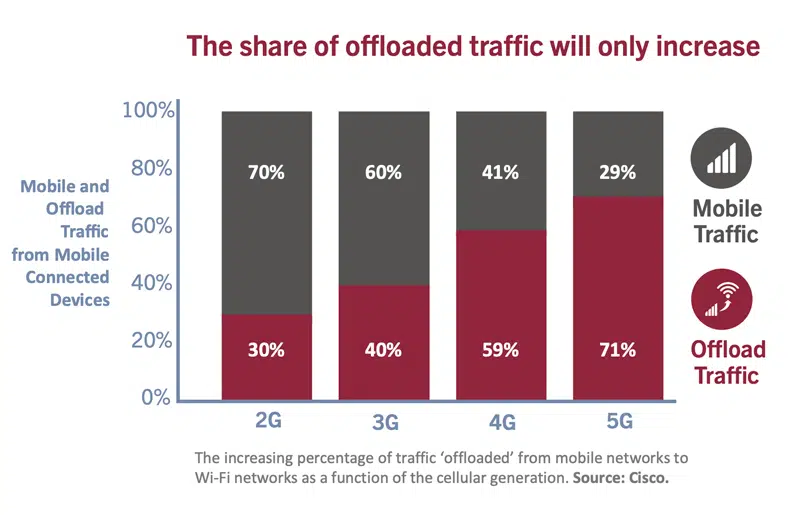
Rapid evolution and availability of new technology and new spectrum are making carrier Wi-Fi inevitable as a strategic technology of choice for service providers everywhere. The idea that Wi-Fi is the dominant indoor wireless technology is not new. But we believe that Wi-Fi’s dominance will be even more pronounced in the 5G era.
It is well known that device data consumption continues to rise particularly as the result of the increased popular demand for video streaming and – more recently perhaps – the explosive demand for collaborative work applications, such as video conferencing. More than this, research suggests (see figure) that the need for mobile networks to ‘offload’ traffic to Wi-Fi will substantially increase in the 5G era.
In some countries – such as the UK, Japan, and Germany – ‘Wi-Fi offload’ percentages (meaning the percentage of smartphone traffic delivered over Wi-Fi networks of any kind) are already well above 80%. In connection with the US decision to allocate all of the 6 GHz band to Wi-Fi, the FCC cited the need for offload from 5G networks as an important contributing factor in their decision.
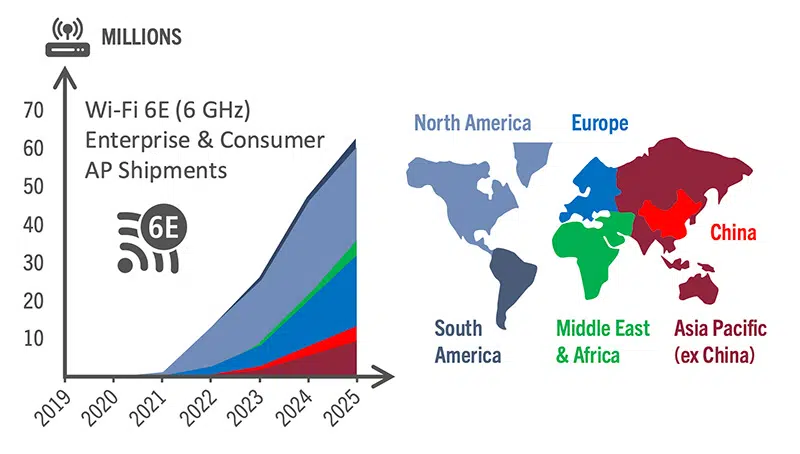
Most analysts believe Wi-Fi 6 and Wi-Fi 6E technology will be ramped up quickly and indeed faster than previous generations of Wi-Fi, specifically because work-from-home connectivity today is business critical for ISPs and consumers. Such factors will continue to play important roles as drivers of renewed connectivity demand as will the continued growth in number of devices in the home as well as data consumption.
The next phase in the ramp-up and deployment of new Wi-Fi technology will then be enterprise and carrier-grade APs and supporting systems. This evolution will happen a little later but also in parallel with the mass-market deployment of home Wi-Fi 6 and Wi-Fi 6E gateways and systems.
In general, the IEEE 802.11 standardization working group is now aiming for a Wi-Fi technology renewal cycle of five years, which means full market penetration of Wi-Fi 6 and Wi-Fi 6E into the enterprise and service provider Wi-Fi markets will sharply rise and come to completion around 2025-26.
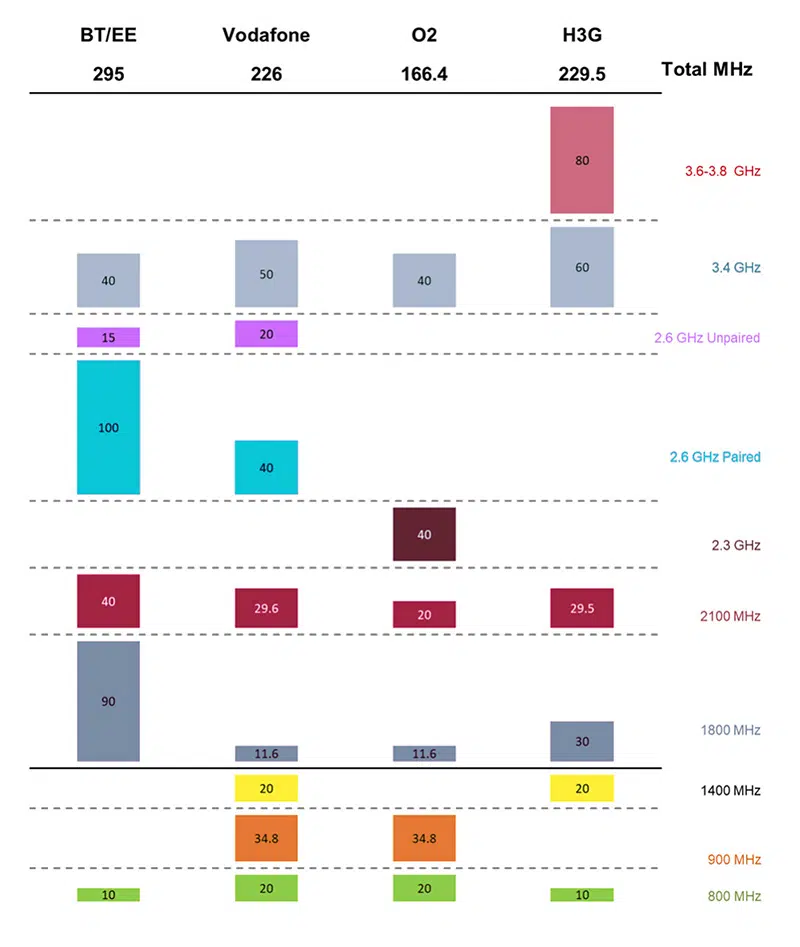
Meanwhile it is critical to understand that the availability of pristine new unlicensed spectrum has made the case for carrier Wi-Fi hugely more compelling. Have a look – for example – at the graphic picturing the total licensed spectrum holdings for mobile operators. The analysis uses the UK as an example.
The most amount of licensed spectrum is held by BT and totals 295 MHz while H3G is in second place totaling 229.5 MHz. None of the UK’s mobile operators hold more than 300 MHz of total licensed spectrum – and most hold much less.
The UK recently released 500 MHz of pristine – meaning unused by legacy Wi-Fi – unlicensed spectrum in the lower 6 GHz band. That slice of Wi-Fi spectrum alone is around double the amount of licensed band that most UK mobile operators hold at this time. Add to this the existing 5 GHz and 2.4 GHz Wi-Fi bands – and we contend that it is becoming increasingly difficult for operators to reject the strategic use of carrier Wi-Fi services. Mobile and fixed operators need to embrace carrier Wi-Fi today to stay competitive.
In countries where the full 1.2 GHz of 6 GHz spectrum (up to 7.2 GHz) has been released – including the US, Korea, Brazil, Saudi Arabia, and the Republic of Chile thus far – the situation is even more extreme. The total amount of unlicensed spectrum available (some of it available for outdoor use as well) could be up to 10 times as much as the licensed spectrum holdings of a single mobile operator.
 Digital learning is the quickest growing market in the education industry, with a whopping 900% growth since 2000. – KPMG
Digital learning is the quickest growing market in the education industry, with a whopping 900% growth since 2000. – KPMG
We are going through unprecedented time and Covid-19 Pandemic has directly impacted every sector possible. However, Internet penetration on a global scale has mitigated the catastrophe to a large extent and became an essential tool to communicate for every sector/industry and specifically for education.
The potential of the Internet in the new-age learning models, Hybrid (online + offline) HyFlex (hybrid+ flexible), is giving access to billions of nuggets of information visible online to learners worldwide.
Broadband technologies empower hybrid+ HyFlex learning with a unique teaching experience, knowledge-sharing, pedagogical expertise while transforming the world as the single largest library.
Internet – a road to Connected Learning.
Internet’s value in improving and enhancing the overall learning experience is undisputed, which got further amplified during the pandemic. The growing adoption of online resources bridges education divides, transforms learning, and improves skills for the globalized economy.
Connecting learners with many educational tools, modules, digital libraries, blogs, wikis, podcasts, videos, e-libraries/textbooks, thereby laying a foundation for a more reliable future, is no more far-fetched.
However, the major spin-off here is slow, low, and no connectivity that breaks the rhythm of learning.
Connectivity challenges & way forward with Wi-Fi 6
Wi-Fi 6 is designed to empower the new age of learning, enabling educational institutions to provide campus-wide connectivity with high-speed, secure Internet by boosting device density. So learners, irrespective of their location, can access, learn and explore futuristic experiential learning anytime and anywhere.
For a brief rundown, Wi-Fi 6 boosts overall performance with increased throughput speeds, higher security, improved network congestion, better client capacity, and reduced power consumption.
-OFDMA (Orthogonal Frequency Division Multiple Access) lets multiple devices be supported with Access Points at a lower latency, minimizing contention for channel access between Wi-Fi devices.
-With Beam Forming feature, Access Point detects where the device requesting the data is located and transmits a more localized data stream in that direction, instead of broadcasting data in all directions, leading to improved speed and high-performance.
-MU-MIMO (Multi-user, multiple-input, multiple-output) enables splitting device data into multiple streams for improved Internet efficiency. Channels are split into even smaller chunks so numerous users can experience simultaneous transmissions.
-1024-QAM (Quadrature Amplitude Modulation) allows more bits to be encoded per symbol transmission over the air using the encoding technology. With this data-encoding density boosted up to 25 percent within the same spectrum, it becomes easier to support more devices simultaneously, even if devices are running throughput-intensive streaming or video apps.
Wi-Fi 6 has ensured that connectivity is no longer a barrier to learning while fostering the education sector to handle the unknown, where learning adapts to each child instead of each child trying to adapt to school. – Anand Kumar, GM-Sales (Govt. Account), HFCL Ltd.
Future dictated by Technology-led learning.
Global E-Learning Market to Reach $457.8 Billion by 2026. – Global News Wire
Connectivity is a driver for inclusive and gender-equal learning, employability and livelihoods. The blended learning model will be a ubiquitous component of the education system worldwide. To narrow digital inequalities, Indian Govt has increased the education budget from Rs 104, 278 crores to Rs 93, 274 crores for 2022-23.
Forward-thinking global institutions like the University of Illinois, Harvard, IIT, IIM, MIT, and so forth are investing extensively in building a resilient mechanism of blended education delivery.
At IO by HFCL, we are equipping, enabling, and advancing digital education globally with our range of access solutions to seize once-in-a-generation learning opportunities to leapfrog children and youth into the future they want and deserve.
Epilogue
The education industry aced the path of ‘disruption to recovery’ amid pandemic with broadband Internet, which acted as a catalyst for the digital revolution. It brought a massive transformation in the learning landscape, technological disruptions while meeting the demand for quality education.
At IO by HFCL, we believe pandemic brought the world an opportunity to rethink and restructure education systems globally. Broadband technology emerged as a panacea enabling learners to learn from anywhere, anytime, in any rhythm, and with any means.
With trending Wi-Fi trends such as Wi-Fi 6, 6E, and 7, it would be easier to build an education system that is more resilient and responsive to students’ needs.
Get in touch with IO by HFCL to penetrate new business markets with a robust Internet-connected system to support seamless and affordable connectivity everywhere.
This article is authored by Mr. Anand Kumar, GM-Sales, HFCL Ltd.

This is an excerpt from our white paper Hyperscale Cellular IoT. If you like what you read, the full white paper is available here. Don’t hesitate to contact Enea if you have any questions. Download white paper here.
In the Hyperscale Cellular IoT white paper, we focus entirely on cellular IoT connectivity. Although cellular IoT will only stand for 22% of all connections at the end of 2026, around 5,9 billion devices will be connected through cellular networks!
The vast majority of IoT connections will be short-range devices using radio technologies such as Wi-Fi, Bluetooth, Z-wave, and Zigbee. But, just like most radio technologies for IoT, cellular connectivity will have rapid growth.
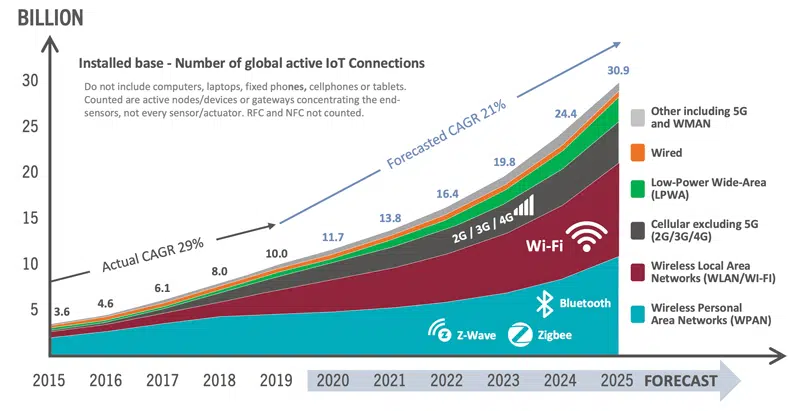
Each technology has its own use case. Cellular is the technology of choice for devices requiring mobility. Short-range technologies such as Wi-Fi are mainly for indoor connectivity. The Low Power Wide Area Networks (LPWAN), including the cellular NB-IoT and technologies such as LoRa, are focused on battery-powered devices with a battery life of up to 10 years.
MANAGEMENT IS KEY FOR IOT
Cellular is the only technology that enables global central management by using the mobile operator’s existing roaming portfolio, typically in 200 or more countries. However, as discussed in our white paper, there are markets where permanent roaming is not a viable option (regulations and/or commercial reasons).
Initiatives such as Aptilo Zero-touch Wi-Fi IoT Connectivity™ and WBA’s OpenRoaming aims to make Wi-Fi-based IoT more seamless and secure also on a global scale.
A CLOSER LOOK AT TECHNOLOGIES FOR CELLULAR IOT
Today, many IoT applications are using the existing 4G (LTE) broadband, which has been improved for IoT. In the last few years, 3GPP has created new standards to better support specific use cases. The largest volume of new IoT devices will come in the Massive IoT area designed to support low-cost wearables, sensors, and meters over long distances. 5G provides the ability to support Critical IoT use cases for real-time mission-critical applications such as connected cars and remote surgery.
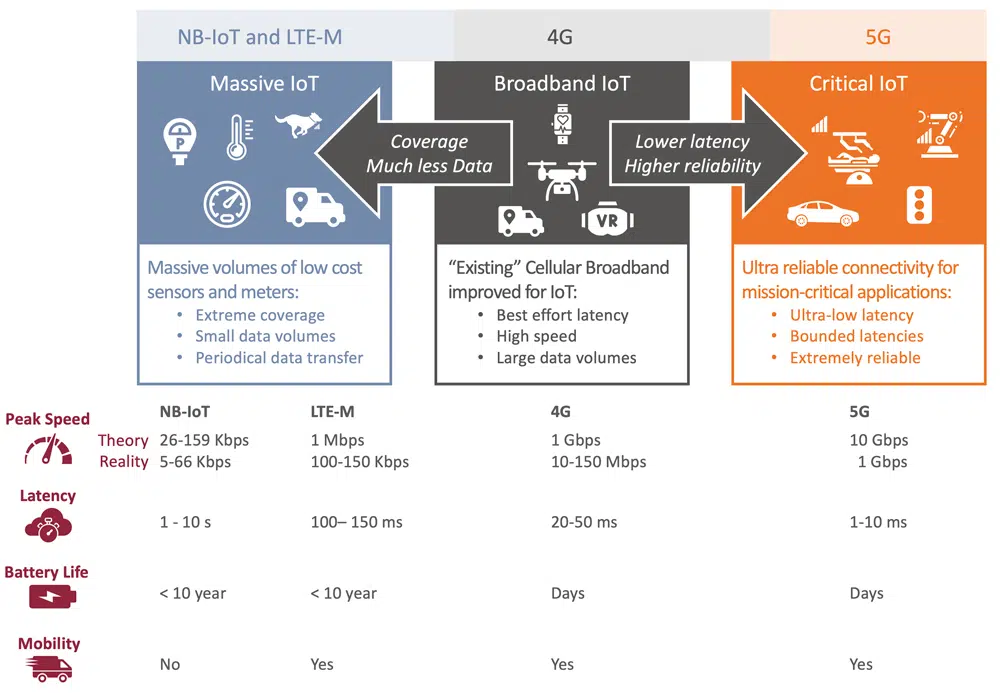
The Massive IoT market segment includes devices that are widely used in our society, mainly different sensors and meters. The NB-IoT and LTE-M technologies are the dominant technologies for Massive IoT. Compared to 4G, they are designed to deliver extreme coverage with much smaller data volumes and mainly periodical transfer of data. This means a battery life of up to 10 years which is ideal for low-cost devices such as smart meters.
NB-IoT is useful for simpler devices that don’t require connected mobility and tolerate low data rates in tens of Kbps and high latency of up to 10 seconds.
For tracking devices where connected mobility is crucial, CAT-M is a better choice. Cat-M also offers support for voice, higher data speeds of up to 1 Mbps and lower latency (100-150 ms).
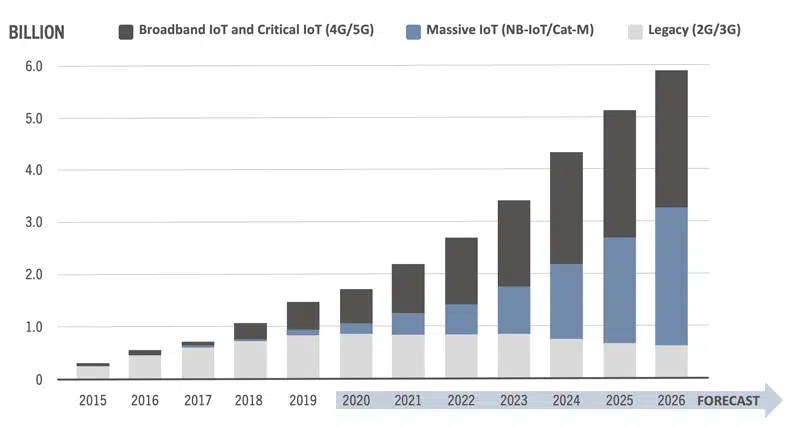
According to the Ericsson Mobility report November 2020, massive IoT (NB-IoT and Cat-M) will have an explosive growth going from almost 200 million connected devices in 2020 to approximately 2.6 billion or 45% of all cellular IoT connections by the end of 2026. At the same time, the total number of cellular IoT devices will be approximately 5.9 billion and 44 percent of those will use broadband IoT and Critical IoT (first devices expected in 2021), with 4G connecting most devices.
The non-cellular long range technology low-power wide-area network (LPWAN) will, according to the same report, go from 200 million to 400 million between 2020-2026.
After screening more than 1,000 companies, Forbes picks Calix as one of the year’s top 50 mid-cap companies based on earnings growth, sales growth, return on equity, and total stock return
SAN JOSE, CA — March 30, 2022 — Calix, Inc. (NYXE: CALX) today announced it has been chosen by global media company Forbes as one of the top 50 companies on its 2022 list of America’s Best Mid-Sized Companies. Calix is the leading provider of cloud and software platforms, systems, and services that enable even the smallest broadband service provider (BSP) to simplify their business to attain the lowest possible OPEX. At the same time, Calix enables them to excite their subscribers with an ever-growing portfolio of experiences that grows subscriber loyalty, brand power, revenue, and community. With more than $1 billion invested in the Intelligent Access EDGE and Revenue EDGE platforms, that mission focused on BSP success has become a reality.
To find the best performers, Forbes used data from FactSet to compile its annual list of America’s Best Mid-Sized Companies. Forbes screened more than 1,000 companies with a market value between $2 billion and $10 billion to find 599 companies that also had positive sales growth over the past 12 months and a share price of at least $5.
Calix drives growth through a unique set of core beliefs and best practices, including:
“Success is all about people. Our award-winning culture is due to our team members adopting the better, better, never best mindset to improve personally and as a team,” said Michael Weening, president and chief operating officer of Calix. “We also have the good fortune to work with incredible people through our BSP partnerships. Customers such as Brad Moline, CEO of ALLO Communications, and Gary Johnson, CEO of Paul Bunyan Communications, are tightly focused on improving their communities and have been critical to the Calix strategy. The Intelligent Access EDGE and Revenue EDGE are unique in the market enabling Calix to bring new capabilities to market at a rate that has never been seen before. Thanks to our partners’ input in our Customer Advisory Boards, we are ensuring that they have the right capabilities to enable incredible success and help their teams crush the consumer giants while achieving their goals of stronger local communities. We are very grateful to our team members and BSP customers for their partnership that made this Forbes award a reality.
Calix is consistently ranked among the best large companies for culture and leadership. Check out the latest opportunities and learn how you can join our award-winning team.
About Calix
Calix, Inc. (NYSE: CALX) – Calix cloud and software platforms enable service providers of all types and sizes to innovate and transform. Our customers utilize the real-time data and insights from Calix platforms to simplify their businesses and deliver experiences that excite their subscribers. The resulting growth in subscriber acquisition, loyalty, and revenue creates more value for their businesses and communities. This is the Calix mission; to enable broadband service providers of all sizes to simplify, excite, and grow.
This press release may contain forward-looking statements that are based upon management’s current expectations and are inherently uncertain. Forward-looking statements are based upon information available to us as of the date of this release, and we assume no obligation to revise or update any such forward-looking statement to reflect any event or circumstance after the date of this release, except as required by law. Actual results and the timing of events could differ materially from current expectations based on risks and uncertainties affecting Calix’s business. The reader is cautioned not to rely on the forward-looking statements contained in this press release. Additional information on potential factors that could affect Calix’s results and other risks and uncertainties are detailed in its quarterly reports on Form 10-Q and Annual Report on Form 10-K filed with the SEC and available at www.sec.gov.
Press Inquiries:
John Husson
410-979-1747
john.husson@calix.com
Investor Inquiries:
Tom Dinges
408-474-0080
tom.dinges@calix.com
Learn how this leading telecommunications operator used Plume’s intelligent cloud-based platform to generate new revenue and achieve an impressive customer penetration rate of 25% with new smart home offerings.